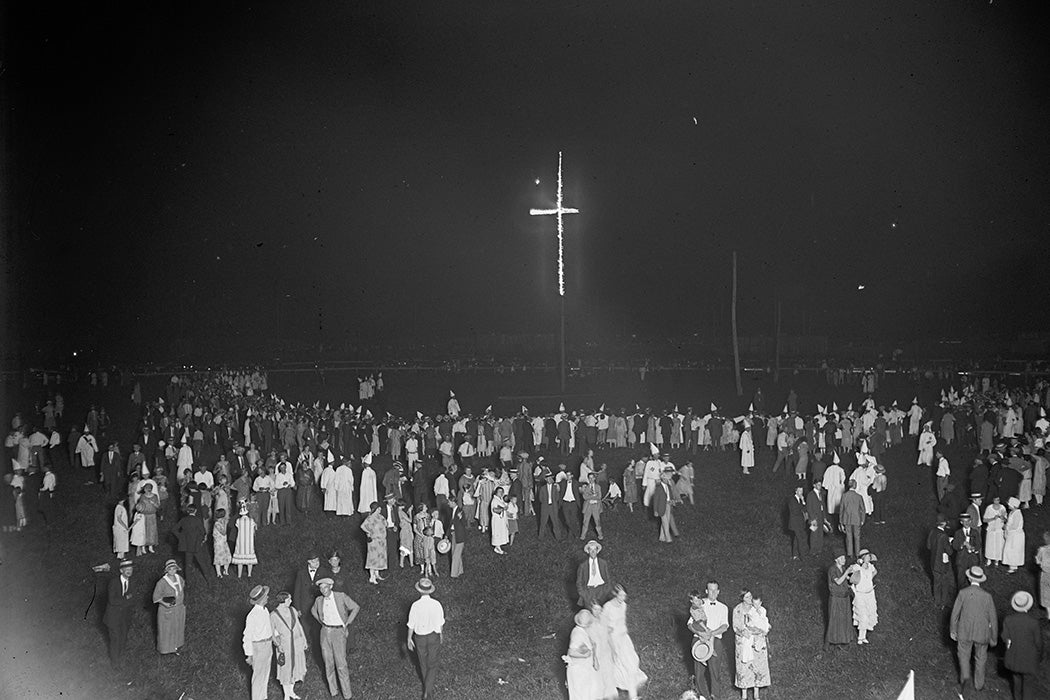Coinciding with the film The Birth of a Nation, the second incarnation of the Ku Klux Klan was founded in Georgia in 1915. The original KKK had been a phenomenon of the defeated Confederacy, the terrorist arm of southern elites using white supremacy to solidify their return to power after Reconstruction. The Roaring Twenties version of the Klan was different. It was a nationwide nativist movement, most powerful in the Midwest and West, where Klan membership was common among public officials. It also lengthened its list of scapegoats to include immigrants, Catholics, and Jews.
As historian William Vance Trollinger Jr. reveals, the Klan hit the campus of the University of Dayton with a dozen bombs and a burning cross in December 1923. Dayton was a Catholic institution in a majority-Protestant city. It was Christmas break, so very few students were around, but with the help of other Dayton residents, they chased the Klansmen off campus.
Trollinger, who teaches at the University of Dayton today, found that this incident and others were barely mentioned in the school’s institutional history and “virtually non-existent in the school’s institutional memory.”
“How does an institution ‘forget’ an exciting, even heroic, story such as this? More to the point, why did the University of Dayton fail to remember three years of dramatic events that included cross burnings, a bombing, and multiple incidents of students confronting hooded invaders?”
Trollinger argues that the school administrators, leery of being seen as too Catholic, downplayed the obvious anti-Catholicism of the Klan. The school had already changed its name from St. Mary’s College in 1920. Eighty-five percent of the student body was Catholic, but they stressed the ecumenical make-up of the school. And in the aftermath of the 1923 attack, administrators stressed that the campus attack was best portrayed as a threat against federal property, meaning the material in the ROTC building. “Given the school’s precarious standing in the community, why continue to bring attention to these incidents?”
Examining this institutional silence, Trollinger wonders if other Catholic institutions of higher ed were targeted by the Klan but chose to remain quiet about it. He found very few mentions of the Klan during this heyday of activity in official histories of colleges and universities. Considering his own school’s history, he thinks there must be more to the story. “A review of histories of Catholic universities in states where the Klan was active reveals a similar silence, even though there are good reasons to believe some of these schools were also targeted by the Klan.”
There is one famous example. In May 1924, the Klan marched through South Bend, Indiana, a heavily Catholic town that is also the home to the University of Notre Dame. Hundreds of Notre Dame students responded by yanking the robes off Klansmen and chasing the Kluxers through town. With the help of quarterback Harry Stuhldreher, they put out the lights of an electric “fiery cross.” Stuhldreher was one of the famed “Four Horsemen of Notre Dame,” who led the Fighting Irish through their undefeated 1924 season.
While Indiana was the “site of the Klan’s greatest achievements” in political power, notes Trollinger, Ohio “may have had more Klan members than any other state in the Union.” There were two Klan newspapers in Dayton, regular cross burnings, and large meetings at the Montgomery Country Fairgrounds on the city’s south side, only blocks from the University of Dayton campus.
Weekly Newsletter
Dayton also had a significant minority of foreign-born residents from central and eastern Europe. Many were Catholics. The University of Dayton, set up in 1850 as the St. Mary’s School for Boys, had a few hundred students by 1923. In Klan eyes, it “served as the headquarters of Catholic subversion in southwest Ohio.” The school’s ROTC program was seen as “training a Catholic army to fight religious wars against American Protestants.” Trollinger calls such rhetoric “standard fare in anti-Catholic literature” produced by people who claimed they were “100 percent Americans” fighting to keep the nation “Christian”—i.e., Protestant.
By downplaying their own Catholicism, the very reason for Klan animus, schools like the University of Dayton may have sidestepped an important lesson about standing up to hate. But their sense of precariousness amid the mainstream bigotry surrounding them seems to have held them back. Trollinger notes that Denver’s Regis College—Colorado was another Klan hotbed—changed its name from Sacred Heart College in 1921. There was at least one cross-burning at Regis in 1924. But “campus lore” about Regis students and faculty patrolling at night to prevent attacks is as close as the institutional history of that school gets to what must have been a frightening time, when everyone from local cops to state governors were potentially Klansmen.







